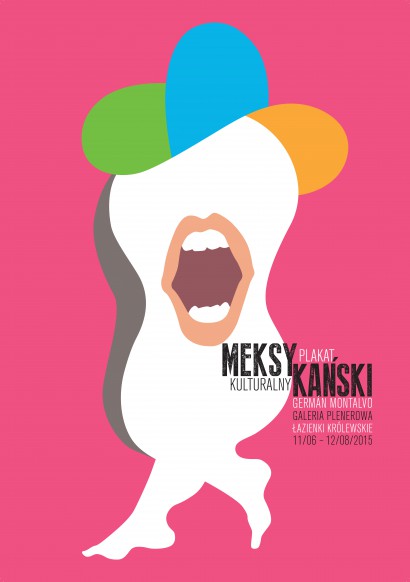Global Design from Puebla
You can’t just walk straight past the eye-catching posters of Germán Montalvo and Benito Cabañas. The motifs they design fascinate contemporary recipients in all corners of the world. The two poster artists make use of the universally understood language of graphic design, in which synthetic signs and symbols are easy to decipher in the context of the cultural events being publicized. However—although the function of the poster to provide information is of paramount importance to the Mexican artists—they do not treat the design work only in terms of its utilitarian value. For them, the ability to convey to the recipients a part of their own sensitivity and imagination, as well as to make a commentary on reality, is of equal importance. “A poster is like a poem,” claims Germán Montalvo.
The basis of the Mexican poster artists-cum-poets’ activity is—to quote Zbigniew Herbert—a recurring dialogue with concrete reality, “with this table, this fellow human being, with this time of day”. Cabañas “contemplates upon” the simplest objects of every-day life which are common to all people anywhere in the world: brooms, flowerpots, crayons, bottle caps…, whereas Montalvo creates modern day monsters taken from the mythology of his Aztec ancestors. Cabañas is interested in creating art for recipients from various cultural spheres; Montalvo analyses the concrete reality of today’s Mexico with its traditions and past, thereby attempting to provoke the recipients into reflecting upon his or her own cultural identity, although his vernacular projects are also perfectly understandable to recipients outside Mexico.
The work of these two graphic artists, who originate from the same town, clearly shows that the idea of a “national school” has ceased to have a raison d’être, and that global design does not have to be synonymous with unification because the merging and transfer of various cultural ideas not only increases the common knowledge required to understand other cultures, but also leads to an enrichment of the repertoire of universal symbols.
The Sacred and the Profane
Deformed, amorphous, humanoid-animal structures, anthropomorphic animals, fruit, and objects—are all constantly recurring motifs in the work of Germán Montalvo. Although sometimes reminiscent of the shape-changing creatures in the series of children’s books about the Barbapapa family, they have nothing in common with the Western comic culture of the 1970s; indeed their origin can be traced back to pre-Columbian traditions—an essential element of inspiration for the artist. However, this fascination is far removed from superficial iconographic borrowings and to the onlooker uninitiated in the mysteries of Aztec mythology, is probably totally incomprehensible. Germán Montalvo goes back to the roots of the myths and suggests a contemporized version of his ancestors’ mythology, thus enabling the ties with pre-Columbian culture—which were severed by the invasion of the Conquistadors—to be reconstructed. In addition to their utilitarian function, which the metaphorical figures in Montalvo’s designs fully meet in every corner of the world, they also acquire an additional ritual function, which is only comprehensible to Latin American recipients. Germán Montalvo’s vernacular designs should therefore not only instantly inform the onlooker about various cultural events, but also encourage him or her to reflect upon questions such as: “Where did we come from?”, “Who are we?”, “Where are we going?”.
Katarzyna Matul
Germán Montalvo (b. in 1956 in Omealca, in the state of Veracruz, Mexico) designs books, posters, ceramics, jewellery and furniture. In 1977 he graduated from the Società Umanitaria, Scuola del Libro in Milan where he studied design. He collaborated with the photographer Mariana Yampolsky on producing graphic art for school textbooks. Scholarship holder of the National Fund for Culture and the Arts (FONCA). He lectures on the history of design at many universities, including the University of the Americas in Puebla (UDLAP) and the University of the Arts (Unarte) in Puebla. His film posters have twice been awarded the Coral prize at the Festival of New Latin American Cinema in Havana. In 1995 he was presented with a prize by the Mexican Academy of Design. In 2009 he received a special prize for his outstanding achievements in the field of design, awarded by the Mexican Designers Council. He has participated in numerous poster competitions in Chicago, Mexico and Bolivia. His work has been exhibited in the Franco Balan Gallery in Aosta, at the Italian Association of Visual Communication Design (AIAP) in Milan, as well as in the DDD Gallery in Osaka. He is a member of Imprenta Madero, as association of designers, and a member of Alliance Graphique Internationale (AGI).
Curator: Michał Batory
Coordination: Magdalena Majewska
Texts: Katarzyna Matul
Translation: Anne-Marie Fabianowska
Editing and proofreading: Paulina Sieniuć, Anne-Marie Fabianowska
